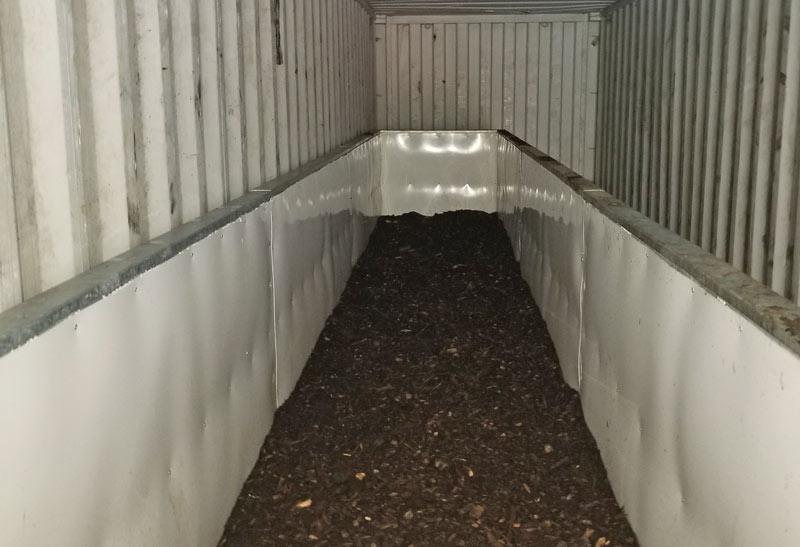
The vermicomposting unit — and its thousands of red wigglers — at Canmore (Alberta) Golf & Curling Club is protected from the elements inside a sea can, or shipping container. Photo by Reid Solodan
When Reid Solodan was first approached about the idea of installing a vermicomposting system at Canmore Golf & Curling Club in Canmore, Alberta, he was skeptical.
“I was hesitant at first,” says Solodan, a GCSAA Class A superintendent and 25-year association member, as well as an Accredited Golf Superintendent (AGS) in the Canadian Golf Superintendents Association. “I guess I’m old-school.”
The worm has turned.
Solodan still describes himself as old-school, but he has more than overcome that initial hesitation over Canmore’s nearly 3-year-old vermicomposting system, whereby thousands of worms turn the club’s grass clippings and food scraps and even wood chips into usable soil.
“Oh, I’m really happy, for sure,” Solodan says. “We bring schools down, classes down to the bin, and show them everything. That education side of it is key, from the community side of it. My daughter and son come down to look at it. Everybody likes worms.”
Well, maybe not everybody, but it would be hard to argue against the benefits of Canmore G&CC’s resident wigglers. For the Canmore team’s efforts, Solodan was recently presented the 2019 CGSA/Rain Bird Environmental Achievement Award.
But first, the backstory.
Christian Wright, a local urban farmer, first approached Solodan about a vermicomposting pilot program. Wright had a smaller operation — sparked by his interest to cut back on the amount of food waste being dumped into the garbage and landfill — and suggested the system would upscale nicely at Canmore Golf & Curling Club.
“He mentioned how it would work, but I was hesitant,” Solodan says. “Obviously, it hadn’t been proven. And I didn’t know how much work it would be. Actually, it’s not much work at all. You just have to think outside the box.”
In this case, most of the work is performed inside the box, and it’s measured in worm-hours, not man-hours.
The vermicomposting system resides in a sea can — a CONEX box or shipping container. The course collects grass clippings in-season, and those clippings compost naturally until the following spring. That partial compost gets piled on top of food scraps from the kitchen. The worms do their thing, breaking down the organic matter and, uh, passing it along. The resulting manure, or castings, is scraped off the bottom of the bin by means of a hand-cranked scraper.
The sifted nutrient-rich casting soil goes in the course’s divot mix with sand and seed. Solodan says the castings make the mix darker, which creates more solar heat and helps grass seed germinate faster.
The vermicompost is also used in the property’s gardens, and Wright uses some in the community garden he tends as part of the Alpine Edible Schoolyards project at local Lawrence Grassi Middle School.
Solodan says he hopes to increase production this summer and plans to try using some of the soil with his topdressing.
In season, he says, the project takes around 10 man-hours a week. In the winter months, the worms slow down considerably and can be maintained by regular infusions of food scraps.
“The biggest issue we’ve had is keeping it warm,” Solodan says. “We have power out there, but we had minus 30 degrees (Celsius, or minus 22 F) over seven days. We had a propane bottle and rented a heater to heat it up a little bit. Getting through the winter is the biggest challenge.”
And the biggest benefit? Arguably the fact that Canmore Golf & Curling Club no longer needs to haul away organic waste.
Solodan says that when he first came to Canmore 16 years ago, the course had a dumpsite for everything from branches to grass clippings to “you name it.” Eventually, that waste would be hauled off site.
“The cost was massive — dumping fees, trucking fees,” Solodan says.
And now?
“We’ve reduced it to where we don’t have any hauling off the property,” he says.
Branches and stumps get ground to chips and mixed into the vermicompost. Larger wood is made available to members for firewood.
“We even have a guy doing bear carvings out of wood,” Solodan says.
Solodan says the initial system cost less than $10,000. A local welder fabricated the vermicomposting bin. The course purchased the sea bin and, from a dealer in nearby Calgary, 4 pounds of red wiggler worms, which have multiplied to around 50 pounds — 50,000 worms.
“I’ve had a lot of questions, for sure,” Solodan says. “I always tell people it’s not a big process. It’s easy to do. I’ve been a superintendent for 16 years and an assistant for seven. I’ve always been old-school, but this has rejuvenated my thinking.”
Andrew Hartsock is GCM’s managing editor.